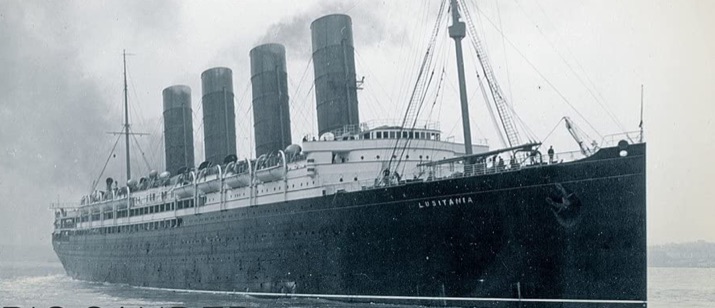Harold Venn was born in the summer of 1887 in Bridgwater, Somerset, England, to George and Annie (nee Jenkins) Venn, who had married in the spring of 1880 in Bridgwater. George, born about 1854 at Over Stowey was employed by with Messrs Colthurst, Symons and Company of Bridgwater, brick and tile manufacturers as a commercial traveller. Annie was born about 1854 at Wembdon, Somerset. The couple had two other children: Reginald George, b. 1881, and Ernest William, b. 20 March 1883 (d. 1979), Ernest was listed in 1901 as an ironmonger’s assistant living with parents parents at Wembdon Road in Bridgwater. At the same time Harold was listed as a boarder, aged 14, at Hart House School, Burnham.
5’9″ tall with brown hair and dark eyes, Harold had left Bridgwater six years before the Lusitania sank embarking on a number of travels. It appears that he first travelled from London to Wellington, New Zealand, as a second cabin passenger on the steamer Athenic, which arrived there 13 July 1909. Then, he seems to have moved on to Sydney, Australia (15 August 1910).There is some evidence that he may also have spent time in Montreal, Canada and also in Toronto. He had also spent some time in Brisbane, Queensland, Australia, in or prior to 1914. In 1914 he travelled to Yokohama, Japan, but he had left there for San Francisco by 7 October, arriving on 23 October 1914, on which voyage he is listed as a commercial traveller, which could explain his globetrotting. He stood 5’9″ tall, had brown hair and dark eyes.

RMS Lusitania was a British ocean liner that was launched by the Cunard Line in 1906 and that held the Blue Riband award for the fastest Atlantic crossing in 1908. It was briefly the world’s largest passenger ship until the completion of the Mauretania three months later.
Harold embarked on the Lusitania for her departure from New York, on 1 May 1915, her 202nd trans-Atlantic voyage. Due to the state of war that existed between Germany and Great Britain and the fact that the ship operated under the control of the British Admiralty the Imperial German Embassy placed a warning advertisement in 50 American newspapers:
NOTICE!
TRAVELLERS intending to embark on the Atlantic voyage are reminded that a state of war exists between Germany and her allies and Great Britain and her allies; that the zone of war includes the waters adjacent to the British Isles; that, in accordance with formal notice given by the Imperial German Government, vessels flying the flag of Great Britain, or any of her allies, are liable to destruction in those waters and that travellers sailing in the war zone on the ships of Great Britain or her allies do so at their own risk.
IMPERIAL GERMAN EMBASSY
Washington, D.C., 22 April 1915.
On 7th May 1915 the Lusitania was sunk by a German U-boat 11 miles off the southern coast of Ireland, killing 1,198 passengers and crew. Harold did not survive.
The Germans argued that Lusitania was regularly transporting war munitions and could be converted into an armed auxiliary cruiser to join the war; also her identity had been disguised; and she flew no flags. They claimed that she was a non-neutral vessel in a declared war zone, with orders to evade capture and ram challenging submarines However, the ship was not armed for battle and was carrying hundreds of civilian passengers. The sinking caused a storm of protest in the United States because 128 American citizens were among the dead. The sinking shifted public opinion in the United States against Germany and was one of the factors in the declaration of war nearly two years later.
Local Press report:

Research: Alan Wheway
